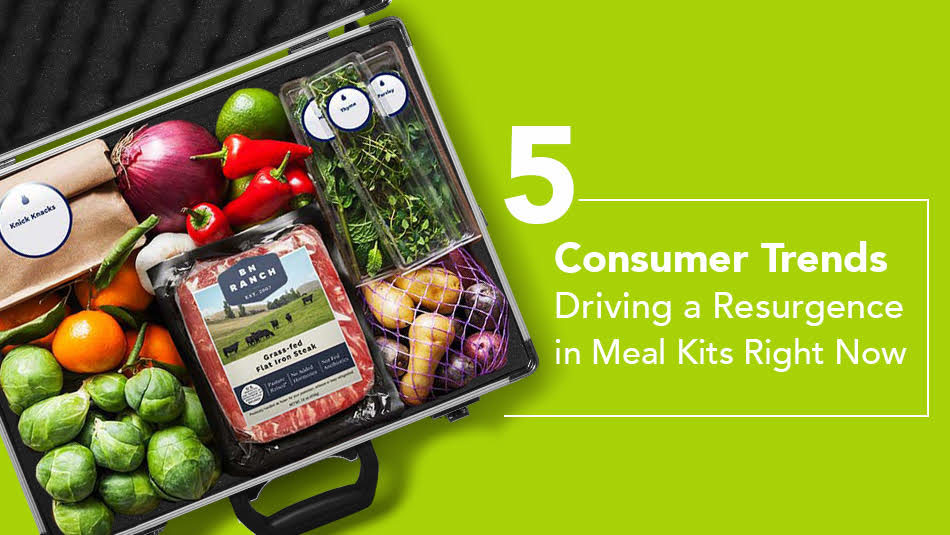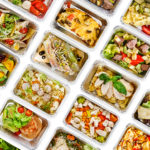
5 Consumer Trends Driving a Resurgence in Meal Kits Right Now
For the meal kit industry, 2020 will be remembered as the year of the comeback.
What consumer trends are driving the resurgence of meal kits right now? Many of the early consumer behavior shifts we saw this year were directly related to COVID-19. However, now months into the pandemic, we’re entering the next phase as new habits become more ingrained. And we’re seeing indirect behaviors emerge, such as meal prepping to address new work-from-home schedules, increased focus on health and weight loss, and even special occasion and holiday planning. Meal kit companies are taking notes as they work hard to fulfill consumer expectations – and secure their ascent. Before we dive in, let’s set the stage for where the industry started at the beginning of the year.
The State of the Meal Kit Industry: How Everything Changed Overnight
To paint a better picture, at the beginning of this year, the state of the industry looked dismal. The only publicly held meal kit company in the U.S., Blue Apron, reported to investors it was facing a significant reduction in customers and orders. And net revenue was down 32% YOY. As their stock plummeted, the buzz of plans for efficiencies, optimizations and consolidations, along with new products, customer acquisition and retention strategies, dominated their earnings calls and reports. The meal kit industry has almost always been challenged with providing value to consumers beyond promotional periods. This is because consumer interests and behaviors have seen continual shifts. And logistical issues like high overhead costs, supply chain issues and scalability have historically challenged the industry.
But over the past six months, the meal kit industry has seen phenomenal growth. Fast-forward to Q3 2020, and Blue Apron reported a 10% net revenue growth in Q2 2020 YOY and a 29% growth over the previous quarter. The company reported acquiring more than 20,000 new customers. For the first time, increased average revenue per customer and average order value rose to their highest values in more than five years. Meanwhile, in their half-year report to investors, German meal kit company HelloFresh reported a 47% increase in active customers in the U.S. along with an 81% increase in orders in Q2 2020.
Meal Kit Companies’ Ability To Respond To Consumers Is Driving Resurgence
As you think about the evolution of meal kits and the drastic changes facing the food industry, it’s important to note the strategic and quick moves meal kit companies are making to stay relevant. These trends not only offer a glimpse into your customers’ lives but they can help you understand how to adjust and adapt your own brand to address their changing needs.
1. Social distancing is driving consumers to food delivery services.
Beyond the early stages of the pandemic, consumers are still turning to some iteration of online grocery to meet their needs, whether it’s through e-commerce or meal kit subscriptions. Why? Home food delivery, including meal kits, has become an essential service for those who want to remain safe at home by helping consumers minimize contact with others. This has become exceedingly valuable, especially to those who are immunocompromised or in self-isolation. And, according to a recent survey, half of the respondents say they will continue to cook at home more often, even after the pandemic is over. According to Vanessa Meyers, SVP Marketing for U.S. meal kit company Sun Basket, “The new normal has accelerated trial and adoption of online food delivery solutions as consumers seek alternatives.”
2. Working from home (WFH) means consumers are looking for more meal options throughout the day.
The continued WFH situation has singles, parents and kids alike not just asking, “What’s for dinner?” Now they are asking, “What’s for breakfast, lunch, dinner and snack time?” Meal kits provide a break from the mundane meals and snacks made from the pantry staple surplus of early quarantine. They also help create a sacred space for families in the kitchen and at the dinner table by serving as a means to cook, eat and enjoy together. Outside of this, consumers are also craving ways to simplify and save time. Yes, kitchen hacks have long been popular, but as the demands of work, personal care and home collide like never before, consumers are desperate for real solutions that make their lives easier. The meal kit industry knows this, and they are responding.
For example, Blue Apron is tapping into the millennial consumer behavior of weekly meal prepping. They are providing kits with enough ingredients to prepare meals for an entire week versus just a single meal. And as we saw in pre-COVID times, the desire for short-prep, ready-to-eat and snacking meal kits continues to grow. Meal kit company Sun Basket has responded with oven-ready meals that can be cooked in the microwave or oven in just six minutes and easy lunches and simple premade meals that just need a protein add-on. Meal kit company Home Chef is showing consumers through their expanded product line of oven-ready, grill-ready and 15-minute meals just how much the company has evolved from offering standard meal kits to broader meal solutions. And to keep tummies full in between meals, snacking kits have seen growth for a variety of tastes. From UrthBox non-GMO organic snacks to Candy Club, the snack box for those with a sweet tooth, there’s truly something for every taste bud.
3. Younger consumers are spending more time in the kitchen and want to learn new cooking skills.
Interest in learning new skills in the kitchen has seen an uptick since the pandemic began because people, in general, are doing so much more cooking at home. This return to the kitchen has made consumers more curious and receptive to learning new skills, making new recipes and experiencing cooking classes online safely, from the comfort of their own kitchens. Thanks to the availability of really great cooking content on platforms like MasterClass or YouTube, consumers can learn just about anything from some of the best chefs in the world. How does the Art of Home Cooking with Alice Waters sound? Or Modern Italian Cooking with Massimo Bottura? Maybe you’re in the mood for something more sophisticated and challenging, like French Pastry Fundamentals with Dominique Ansel, known for his mile-long lines for the famous Cronut in New York City. Whatever you’re craving, there’s an online class for that!
Having taken notice, many restaurants have leveraged the trend in online learning with a more diversified offering that includes takeout, groceries and meal kits, along with custom virtual cooking classes. Even colleges and universities have jumped on the bandwagon and are beginning to offer students prepackaged meal kits and interactive videos to help them learn how to cook.
For the meal kit consumer, these offerings may even serve to emotionally bridge the gap between a regular meal at home and a special meal at a restaurant (although still not quite the same as treating yourself to the experience of being served in a restaurant). While many restaurants have jumped on board to offer this level of engagement to their customers alongside their meal kits, it remains to be seen if the meal kit industry as a whole will do the same.
4. Weight management systems are on the rise as consumers deal with the “quarantine 15.”
According to a new study by Nutrisystem, 76% of Americans have gained up to 16 pounds since the pandemic began. This is a direct result of struggling to remain active and stick to a healthy meal regimen during the quarantine. The good news, according to the study, is that 63% of Americans are now prioritizing weight loss to counteract the dietary choices they made during the early days of lockdown. With the time and energy restrictions of this new era of doing everything from home, ultimately, well-structured meal kits can help Americans meet their dietary and weight-loss goals.
Specialty-diet meal kits catering to gluten-free, paleo or plant-based interests have been on the rise since 2018. But with the increased focus on weight loss and dietary goals, health-focused meals kits like Daily Harvest, Purple Carrot and others are sure to experience an uptick in demand.
5. Travel restrictions and the holidays have consumers “looking forward to looking forward.”
Despite airline companies’ efforts to woo customers, 58% of consumers are not planning to travel for the holiday season this year. Zeta Global, a data company focused on consumer trends, points to a few factors for this decline. Its CEO, David A. Steinberg, says, “People are generally scared to fly and also have economic uncertainty.” As a result, many consumers will be staying close to home for the holidays this year, and as it turns out, many are looking to make the best of the situation.
According to Pinterest’s 2020 Guide to the Holidays, consumers began planning for holidays like Thanksgiving and Christmas back in April. This trend is what Pinterest calls “looking forward to looking forward.” Consumers are pinning everything they can to make their holidays at home more special – from holiday fashion, beauty and decor to Christmas party food and nostalgic Christmas baking recipes. Christmas party food saw pinning surges of 4x YOY and Christmas baking recipes 5x YOY. In past years, only four in 10 Pinners said they care about micro-holidays like Friendsgiving or New Year’s brunch. But this year, seven out of 10 say they’ll celebrate the smaller moments. “For me, Friendsgiving evokes a feeling of togetherness, community and reminds us that we all have each other. It instills a feeling of family outside of actual blood family,” says one anonymous 28-year-old Pinner, hinting at the opportunity that meal kits and food brands have to be a part of these moments.
What does this have to do with meal kits? Fifty percent of Pinners say they want help from brands in taking their holiday experiences to the “next level.” Meal kits can act on this insight by enhancing their holiday and special occasion offerings in 2020. For example, in 2019, Blue Apron, HelloFresh, Home Chef and Marley Spoon, among others, offered special holiday meal kits. This year, the meal kit industry has a real opportunity to make an emotional connection with consumers not only on these big holidays but also for the micro-holidays they are looking forward to as well.
Food brands and commodities can look to these trends, emulate the strategies and tactics, and maybe even get in on the action through brand partnerships.
Change Breeds Innovation and Opportunities for Meal Kit Companies and Food Marketers
Will these changes in consumer behavior be enough to sustain long-term growth for meal kits? We’ll have to wait and see, but time and time again the meal kit space has proven that “necessity is the mother of invention.”
With continued investment in building meaningful connections with their customers, especially during challenging times, meal kit companies have elevated their position and place in homes across America. Their agility and ability to pivot their value to the consumer continue to be their core strengths. This is why CPG brands should pay close attention to what is happening in the meal kit arena. Meal kit companies might just be a new breed of “influencer” that food brands are looking for.






